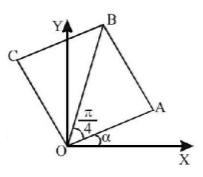Question
A square of side a lies above the $$x$$-axis and has one vertex at the origin. The side passing through the origin makes an angle $$\alpha \left( {0 < \alpha < \frac{\pi }{4}} \right)$$ with the positive direction of $$x$$-axis. The equation of its diagonal not passing through the origin is-
A.
$$y\left( {\cos \,\alpha + \sin \,\alpha } \right) + x\left( {\cos \,\alpha - \sin \,\alpha } \right) = a$$
B.
$$y\left( {\cos \,\alpha - \sin \,\alpha } \right) - x\left( {\sin \,\alpha - \cos \,\alpha } \right) = a$$
C.
$$y\left( {\cos \,\alpha + \sin \,\alpha } \right) + x\left( {\sin \,\alpha - \cos \,\alpha } \right) = a$$
D.
$$y\left( {\cos \,\alpha + \sin \,\alpha } \right) + x\left( {\sin \,\alpha + \cos \,\alpha } \right) = a$$
Answer :
$$y\left( {\cos \,\alpha + \sin \,\alpha } \right) + x\left( {\cos \,\alpha - \sin \,\alpha } \right) = a$$
Solution :
Co-ordinates of $$A = \left( {a\,\cos \,\alpha ,\,a\,\sin \,\alpha } \right)$$

Equation of OB,
$$\eqalign{ & y = \tan \left( {\frac{\pi }{4} + \alpha } \right)x \cr & {\text{CA}}{ \bot ^{\text{r}}}{\text{OB}} \cr & \therefore \,{\text{slope of CA }} = - \cot \left( {\frac{\pi }{4} + \alpha } \right) \cr} $$
Equation of CA
$$\eqalign{ & y - a\,\sin \,\alpha = - \cot \left( {\frac{\pi }{4} + \alpha } \right)\left( {x - a\,\cos \,\alpha } \right) \cr & \Rightarrow \left( {y - a\,\sin \,\alpha } \right)\left( {\tan \left( {\frac{\pi }{4} + \alpha } \right)} \right) = \left( {a\,\cos \,\alpha - x} \right) \cr & \Rightarrow \left( {y - a\,\sin \,\alpha } \right)\left( {\frac{{\tan \frac{\pi }{4} + \tan \,\alpha }}{{1 - \tan \frac{\pi }{4}\tan \,\alpha }}} \right) = \left( {a\,\cos \,\alpha - x} \right) \cr & \Rightarrow \left( {y - a\,\sin \,\alpha } \right)\left( {1 + \tan \,\alpha } \right) = \left( {a\,\cos \,\alpha - x} \right)\left( {1 - \tan \,\alpha } \right) \cr & \Rightarrow \left( {y - a\,\sin \,\alpha } \right)\left( {\cos \,\alpha + \,\sin \,\alpha } \right) = \left( {a\,\cos \,\alpha - x} \right)\left( {\cos \,\alpha - \sin \,\alpha } \right) \cr & \Rightarrow y\left( {\cos \,\alpha + \sin \,\alpha } \right) - a\,\sin \,\alpha \,\cos \,\alpha - a\,{\sin ^2}\alpha = a\,{\cos ^2}\alpha - a\,\cos \,\alpha \,\sin \,\alpha - x\,\left( {\cos \,\alpha - a\,\sin \,\alpha } \right) \cr & \Rightarrow y\left( {\cos \,\alpha + \,\sin \,\alpha } \right) + x\left( {\cos \,\alpha - \,\sin \,\alpha } \right) = a \cr & y\left( {\,\sin \,\alpha + \,\cos \,\alpha } \right) + x\left( {\cos \,\alpha - \,\sin \,\alpha } \right) = a \cr} $$
Co-ordinates of $$A = \left( {a\,\cos \,\alpha ,\,a\,\sin \,\alpha } \right)$$

Equation of OB,
$$\eqalign{ & y = \tan \left( {\frac{\pi }{4} + \alpha } \right)x \cr & {\text{CA}}{ \bot ^{\text{r}}}{\text{OB}} \cr & \therefore \,{\text{slope of CA }} = - \cot \left( {\frac{\pi }{4} + \alpha } \right) \cr} $$
Equation of CA
$$\eqalign{ & y - a\,\sin \,\alpha = - \cot \left( {\frac{\pi }{4} + \alpha } \right)\left( {x - a\,\cos \,\alpha } \right) \cr & \Rightarrow \left( {y - a\,\sin \,\alpha } \right)\left( {\tan \left( {\frac{\pi }{4} + \alpha } \right)} \right) = \left( {a\,\cos \,\alpha - x} \right) \cr & \Rightarrow \left( {y - a\,\sin \,\alpha } \right)\left( {\frac{{\tan \frac{\pi }{4} + \tan \,\alpha }}{{1 - \tan \frac{\pi }{4}\tan \,\alpha }}} \right) = \left( {a\,\cos \,\alpha - x} \right) \cr & \Rightarrow \left( {y - a\,\sin \,\alpha } \right)\left( {1 + \tan \,\alpha } \right) = \left( {a\,\cos \,\alpha - x} \right)\left( {1 - \tan \,\alpha } \right) \cr & \Rightarrow \left( {y - a\,\sin \,\alpha } \right)\left( {\cos \,\alpha + \,\sin \,\alpha } \right) = \left( {a\,\cos \,\alpha - x} \right)\left( {\cos \,\alpha - \sin \,\alpha } \right) \cr & \Rightarrow y\left( {\cos \,\alpha + \sin \,\alpha } \right) - a\,\sin \,\alpha \,\cos \,\alpha - a\,{\sin ^2}\alpha = a\,{\cos ^2}\alpha - a\,\cos \,\alpha \,\sin \,\alpha - x\,\left( {\cos \,\alpha - a\,\sin \,\alpha } \right) \cr & \Rightarrow y\left( {\cos \,\alpha + \,\sin \,\alpha } \right) + x\left( {\cos \,\alpha - \,\sin \,\alpha } \right) = a \cr & y\left( {\,\sin \,\alpha + \,\cos \,\alpha } \right) + x\left( {\cos \,\alpha - \,\sin \,\alpha } \right) = a \cr} $$